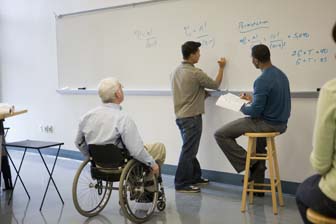Mathematician or Statistician
Mathematician or Statistician
Does this career fit your work personality?
Begin The Career Assessment Test- Best Fitting Careers
- Work Personality Strengths
- Work Style Preferences
- and more
What Mathematicians and Statisticians Do
Mathematicians and statisticians analyze data and apply computational techniques to solve problems.
Duties
Mathematicians and statisticians typically do the following:
- Decide what data are needed to answer specific questions or problems
- Apply mathematical theories and techniques to solve practical problems in business, engineering, the sciences, and other fields
- Design surveys, experiments, or opinion polls to collect data
- Develop mathematical or statistical models to analyze data
- Interpret data and communicate analyses to technical and nontechnical audiences
- Use statistical software to analyze data and create visualizations to aid decision making in business
To solve problems, mathematicians rely on statisticians to design surveys, questionnaires, experiments, and opinion polls for collecting the data they need. For most surveys and opinion polls, statisticians gather data from some people in a particular group. Statisticians determine the type and size of this sample for collecting data in the survey or poll.
Following data collection is analysis, which involves mathematicians and statisticians using specialized statistical software. In their analyses, mathematicians and statisticians identify trends and relationships within the data. They also conduct tests to determine the data’s validity and to account for possible errors. Some help write software code to analyze data more accurately and efficiently.
Mathematicians and statisticians present findings from their analyses and discuss the data’s limitations in order to ensure accurate interpretation. They may present written reports, tables, and charts to team members, clients, and other users.
Mathematicians and statisticians work in any field that benefits from data analysis, including education, government, healthcare, and research and development.
Colleges and universities. Mathematicians and statisticians working in postsecondary schools may study theoretical or abstract concepts in these fields. They identify, research, and work to resolve unexplained issues in mathematics and explore mathematical or statistical theories to increase knowledge and understanding about the field.
Government. Mathematicians and statisticians working in government develop surveys and collect and analyze data on a variety of topics, including employment, crop production, and energy use. At all levels of government, these data help to inform policy proposals and decisions that affect the public.
Healthcare. Statisticians known as biostatisticians or biometricians work in pharmaceutical companies, public health agencies, or hospitals. They may design studies to test whether drugs successfully treat diseases or medical conditions. They may also help identify the sources of outbreaks of illnesses in humans and animals.
Research and development. Mathematicians and statisticians design experiments for product testing and development. For example, they may help design experiments to see how car engines perform when exposed to extreme weather or analyze consumer data for use in developing marketing strategies.
Typically, mathematicians and statisticians work on teams with other specialists to solve problems. For example, they may work with chemists, materials scientists, and chemical engineers to analyze the effectiveness of a new drug or help data scientists develop statistical models.
Work Environment

Mathematicians held about 2,300 jobs in 2022. The largest employers of mathematicians were as follows:
| Federal government | 54% |
| Professional, scientific, and technical services | 19 |
| Colleges, universities, and professional schools; state, local, and private | 16 |
Statisticians held about 33,300 jobs in 2022. The largest employers of statisticians were as follows:
| Research and development in the physical, engineering, and life sciences | 16% |
| Federal government | 16 |
| Colleges, universities, and professional schools; state, local, and private | 11 |
| Healthcare and social assistance | 7 |
| Computer systems design and related services | 6 |
Mathematicians and statisticians typically work in offices. They also may work on teams with engineers, scientists, and other specialists.
Work Schedules
Most mathematicians and statisticians work full time. Deadlines and last-minute requests for data or analysis may require overtime. In addition, these workers may travel to attend seminars and conferences.
Getting Started
How to Become a Mathematician or Statistician

Mathematicians and statisticians typically need at least a master’s degree in mathematics or statistics. However, some positions are available to those with a bachelor’s degree.
Education
Students who are interested in becoming mathematicians or statisticians should take as many math courses as possible in high school.
For jobs with the federal government, candidates need at least a bachelor’s degree or significant coursework in mathematics. In private industry, mathematicians typically need either a master’s or a doctoral degree; statisticians typically need a master's degree, but some entry-level positions may accept candidates with a bachelor's degree.
Most colleges and universities have bachelor’s degree programs in mathematics. Courses usually include calculus, differential equations, and linear and abstract algebra. Mathematics students also commonly take courses in a related field, such as computer science, physics, or statistics.
Many universities offer master’s and doctoral degrees in theoretical or applied mathematics. Students who get a doctoral degree may work as professors of mathematics in a college or university.
Statisticians typically need a master’s degree, but some entry-level positions may accept candidates with a bachelor’s degree.
Students majoring in statistics also may take courses in another field, such as computer science, life sciences, or physical sciences. These courses may help prepare students to work in a variety of industries. For example, coursework in biology, chemistry, or health sciences is useful for testing pharmaceutical or agricultural products. Physics may be useful for statisticians working in manufacturing on quality improvement.
Advancement
Mathematicians and statisticians may advance to become senior mathematicians or statisticians or to work in other managerial roles. A master’s or doctoral degree may be required for some advancement opportunities.
Job Outlook
Overall employment of mathematicians and statisticians is projected to grow 30 percent from 2022 to 2032, much faster than the average for all occupations.
About 3,500 openings for mathematicians and statisticians are projected each year, on average, over the decade. Many of those openings are expected to result from the need to replace workers who transfer to different occupations or exit the labor force, such as to retire.
Employment
Projected employment of mathematicians and statisticians varies by occupation (see table). Employment growth for statisticians is expected to result from more widespread use of statistical analysis to inform business, healthcare, and policy decisions. The amount of digitally stored data will increase over the projections decade as people and companies continue to conduct business online and use social media, smartphones, and other mobile devices. As a result, businesses will increasingly need statisticians to analyze the large amount of information and data collected. Statistical analyses will help companies improve their business processes, design and develop new products, and advertise products to potential customers.
Contacts for More Information
For more information about mathematicians, including training, especially for doctoral-level employment, visit
For more information about statisticians, visit
American Statistical Association
For specific information on careers in applied mathematics, visit
Society for Industrial and Applied Mathematics
For information on federal government requirements for mathematician positions, visit
U.S. Office of Personnel Management
Similar Occupations
This table shows a list of occupations with job duties that are similar to those of mathematicians and statisticians.
| Occupation | Job Duties | Entry-Level Education | Median Annual Pay, May 2022 | |
|---|---|---|---|---|

|
Actuaries |
Actuaries use mathematics, statistics, and financial theory to analyze the economic costs of risk and uncertainty. |
Bachelor's degree | $113,990 |

|
Computer Systems Analysts |
Computer systems analysts study an organization’s current computer systems and design ways to improve efficiency. |
Bachelor's degree | $102,240 |

|
Data Scientists |
Data scientists use analytical tools and techniques to extract meaningful insights from data. |
Bachelor's degree | $103,500 |

|
Financial Analysts |
Financial analysts guide businesses and individuals in decisions about expending money to attain profit. |
Bachelor's degree | $96,220 |

|
Market Research Analysts |
Market research analysts study consumer preferences, business conditions, and other factors to assess potential sales of a product or service. |
Bachelor's degree | $68,230 |

|
Operations Research Analysts |
Operations research analysts use mathematics and logic to help solve complex issues. |
Bachelor's degree | $85,720 |

|
Postsecondary Teachers |
Postsecondary teachers instruct students in a variety of academic subjects beyond the high school level. |
See How to Become One | $80,840 |

|
Survey Researchers |
Survey researchers design and conduct surveys and analyze data. |
Master's degree | $60,410 |

|
Economists |
Economists conduct research, prepare reports, and evaluate issues related to monetary and fiscal policy. They also may collect and analyze statistical data. |
Master's degree | $113,940 |

|
Computer Programmers |
Computer programmers write, modify, and test code and scripts that allow computer software and applications to function properly. |
Bachelor's degree | $97,800 |

|
Physicists and Astronomers |
Physicists and astronomers study the interactions of matter and energy. |
Doctoral or professional degree | $139,220 |
